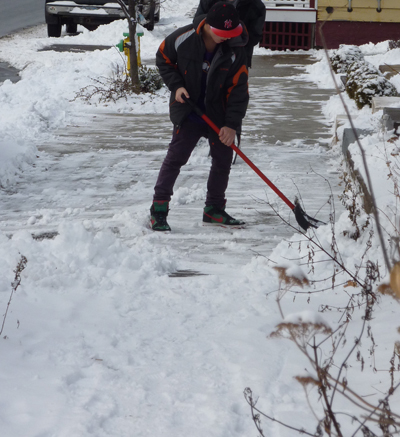Soil Science Society of America
5585 Guilford Road • Madison, WI 53711-5801 • 608-273-8080 • Fax 608-273-2021
www.soils.org
Twitter | Facebook
NEWS RELEASE
Contact: Hanna Jeske, Associate Director of Marketing and Brand Strategy, 608-268-3972, hjeske@sciencesocieties.org
Putting sidewalks on low-sodium diet
Jan. 3, 2017 – Wintry weather can pack a slippery punch. While use of salt on roads and sidewalks can return surfaces to a safer status, too much salt can have long-term effects on soil. The Soil Science Society of America (SSSA) January 1 Soils Matter blog post explains how too much salt reduces soils’ ability to retain plant nutrients and water, and damage soil structure.
 Salts that blow off the pavement or flows away with melted ice and snow wreak havoc on soil systems. “Soils that contain too much sodium are unable to effectively retain important plant nutrients,” says blog author Mary Tiedeman. “Sodium in soils can also reduce plant-available water, and is even toxic to many plant species.”
Salts that blow off the pavement or flows away with melted ice and snow wreak havoc on soil systems. “Soils that contain too much sodium are unable to effectively retain important plant nutrients,” says blog author Mary Tiedeman. “Sodium in soils can also reduce plant-available water, and is even toxic to many plant species.”
The troubles don’t end there, however. “Sodium contamination leads to the breakdown of soil aggregates (or clumps),” Tiedeman says. “Water and air cannot move as easily through the soil. This process makes for a harsh environment for plants. It also has water quality ramifications, as surface soils erode far more readily when water cannot easily penetrate the soil surface."
If you are concerned about the health of your soil and nearby water resources:
- Be proactive with shoveling
- Use the smallest amount of salt necessary
- Wet deicers before application
- Use kitty litter or sand for traction
To read the entire blog post, visit http://soilsmatter.wordpress.com.
Follow SSSA on Facebook at https://www.facebook.com/SSSA.soils, Twitter at SSSA_Soils. SSSA has soils information on www.soils.org/discover-soils, for teachers at www.soils4teachers.org, and for students through 12th grade, www.soils4kids.org.